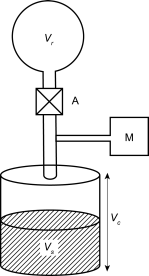Appendix XVII K. Pycnometric Density of Solids
Gas pycnometric density is determined by measuring the volume occupied by a known mass of powder, which is equivalent to the volume of gas displaced by the powder using a gas displacement pycnometer. In gas pycnometric density measurements, the volume determined excludes the volume occupied by open pores; however, it includes the volume occupied by sealed pores or pores inaccessible to the gas.
Usually, helium is used as a test gas due to its high diffusivity into small open pores. If gases other than helium are used, different values would be obtained, since the penetration of the gas is dependent on the size of the pore as well as the cross-sectional area of the gas molecules.
The measured density is a volume-weighted average of the densities of individual powder particles. It is called the particle density, distinct from the true density of a solid or the bulk density of a powder. The density of solids is expressed in grams per cubic centimetre (g/cm3), although the International Unit is the kilogram per cubic metre (1 g/cm3 = 1000 kg/m3).
APPARATUS
The apparatus (see Figure 2.9.23.-1) consists of the following:
The gas pycnometric density measurement is performed at a temperature between 15 °C and 30 °C that does not vary by more than 2 °C during the course of measurement.
The apparatus is calibrated, which means that the volumes Vc and Vr are determined using a suitable calibration standard whose volume is known to the nearest 0.001 cm3. The procedure described below is followed in 2 runs, firstly with an empty test cell, and secondly with the calibration standard placed in the test cell. The volumes Vc and Vr are calculated using the equation for the sample volume (Vs), taking into account that Vs is zero in the first run.
| A | = | valve; |
| Vr | = | expansion volume, in cubic centimetres; |
| Vc | = | cell volume, in cubic centimetres; |
| Vs | = | sample volume, in cubic centimetres; |
| M | = | manometer. |
METHOD
Volatile contaminants in the powder are removed by degassing the powder under a constant purge of helium prior to the measurement. Occasionally, powders may have to be degassed under vacuum. Because volatiles may be evolved during the measurement, weighing of the sample is carried out after the pycnometric measurement of volume.
Weigh the test cell of the pycnometer and record the mass. Fill the test cell with a given mass of powder of the substance to be examined. Seal the test cell in the pycnometer. Record the system reference pressure (Pr) as indicated by the manometer while the valve that connects the expansion cell with the test cell is open. Close the valve to separate the expansion cell from the test cell. Pressurise the test cell with the gas to an initial pressure (Pi) and record the value obtained. Open the valve to connect the expansion cell with the test cell. Record the final pressure (Pf). Repeat the measurement sequence for the same powder sample until consecutive measurements of the sample volume (Vs) agree to within 0.2 per cent. Unload the test cell and measure the final powder mass (m), expressed in grams. If the pycnometer differs in operation or construction from the one shown in Figure 2.9.23.-1, follow the instructions of the manufacturer of the pycnometer.
EXPRESSION OF THE RESULTS
The sample volume (Vs) is given by the equation:
The density (ρ) is given by the equation:
The sample conditioning is indicated with the results. For example, indicate whether the sample was tested as is or dried under specific conditions such as those described for loss on drying.


